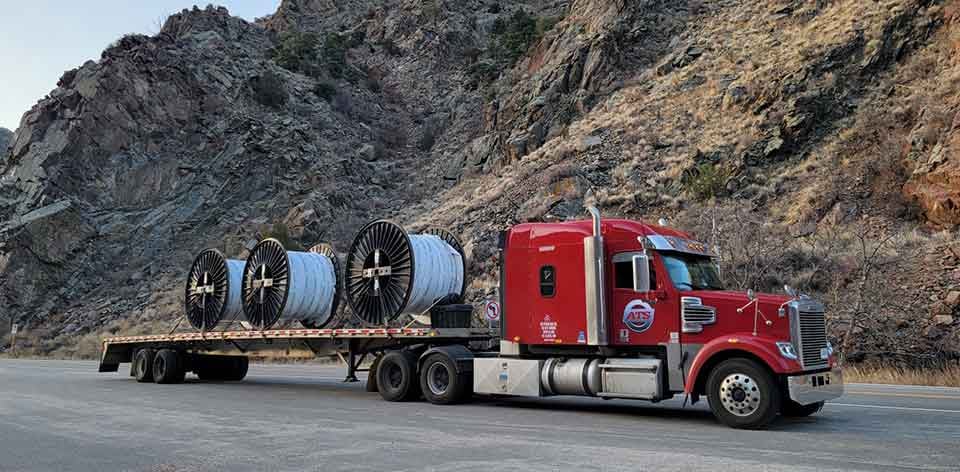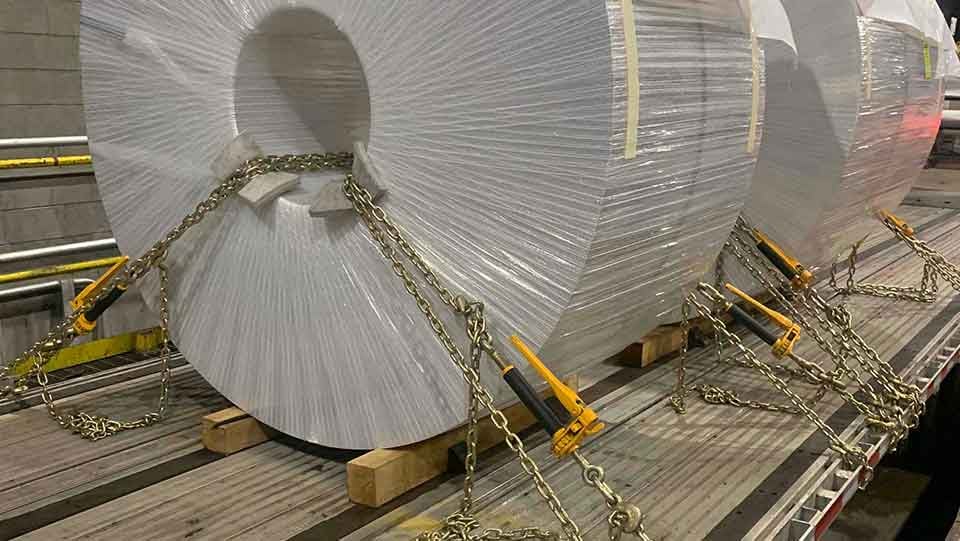Long strips of metal, including steel, aluminum and fiber optic cable, are often wrapped around a coil or spool for shipping. Coiling this type of material saves space and keeps it manageable during transportation and storage.
Transporting circular objects presents a unique set of challenges. Specifically, the natural tendency of these coils (which can each weigh ten of thousands of pounds) is to roll back and forth.
Whether you’re the one shipping the coils or the one in the car following a trailer load of coils, your first concern is probably safety. Fortunately, that’s always the first concern of the driver as well.
At Anderson Trucking Service (ATS), we safely transport coils every day. We use a combination of methods to keep these coils locked in place, stopping potential damage to the coil itself, the truck, the trailer, the driver and everything else on the route. We’ve been in the trucking industry for over 65 years, and our expertise has reinforced fool-proof methods to safely transport coils.
To ensure the safety of your shipments — and all stakeholders adjacent to it — it’s important you know what proper handling and securement looks like for coiled products. In this article, you’ll learn exactly what you need to keep in mind, watch out for and consider the next time your coiled cargo hits the road.
Two Methods of Shipping Coils: Eye to the Sky or Eye to the Side
Coils can travel either sitting flat on the truck or resting on the circular edge. These two shipping types are named for the position of the center or “eye” of the coil: eye to the sky (center of the coil is facing up and down, coil is resting flat on the side) or eye to the side (center of the coil is facing sideways, coil is resting on the circular edge).
Coils are transported eye to the sky or eye to the side based on the type of the product (some materials can compress during an eye-to-the-sky shipment), weight of the product (sturdy, heavy loads are usually transported eye to the side) and shipper preference (based on their expertise shipping their particular product).
Regardless of how the coils will be transported, the driver is responsible for securing the coils and ensuring they arrive safely and undamaged.
Securing Eye-to-the-Side Coils

Eye-to-the-side coil reels are secured so they do not bounce or roll in any direction. Securing these starts with suspending the coil above the trailer and then using tiedowns to secure the load to the trailer.
From here, there are a couple of options for situating and suspending these loads during transit (for ease of loading/unloading and securement).
Beveled Dunnage or Steel Racks
Once the level surface is prepared, coils are held above the surface of the trailer, separated from its deck, using either beveled dunnage or steel racks.
- Beveled dunnage is sturdy 4x4 or 6x6 timber (usually oak) angled to 12.5 degrees. This slight angle is slid under the rolling edges of the coil to cradle it above ground and hold it in place. Beveled dunnage on both sides stops coils from rolling in either direction.
- Coil racks are another option to suspend each coil during transport. These steel bars rest on the trailer and have upright steel posts a few inches high that are angled to suspend the coil and prevent rolling. Typically, one rack is required per 10,000 pounds of weight.
- Friction mats are rubber mats laid on the flat surface to prevent the beveled dunnage or coil racks from sliding or skidding.
- Chocks are taller blocks placed outside of the beveled dunnage that create a physical barrier to stop rolling.
This base level of securement is the first step in keeping coil reels in place, and is combined with tie downs to provide further protection for the freight, driver and the public.
Tiedowns for Eye-to-the-Side Coils
After the eye-to-the-side coil is resting on a secure surface, chains or straps are used as tie downs to stop the coil from rolling or bouncing.

Federal regulations require one tie down for every 10,000 pounds of weight, and each tiedown must be rated to half the cargo’s total weight. For example, a 50,000 pound coil will have five tie downs, each rated to hold 25,000 pounds. These regulations ensure safety even in the unlikely event that one of the tiedowns fails.
Tiedowns may be fed through the eye of the coil, strapped over the top or both. Tiedowns are tightened to keep them taut during transit. Depending on the number of tiedowns needed, one or more may loop around the bottom of the coil as well.
When the driver has secured an eye-to-the-side coil, it will not roll or move in any direction. Proper securement means that eye-to-the-side coils won’t live up to their unfortunate nickname as shotgun or “suicide” coils.
Ready to learn more about the best way to ship your commodity? Contact ATS for a quote.
Securing Eye-to-the-Sky Steel Coils
Eye-to-the-sky coils travel resting on their flat sides. While this means there is no risk of the coil rolling out of place, they are still heavy and must be secured.
Like eye-to-the-side coils, the first level of securement for eye-to-the-sky coils is dunnage and friction matts. A flat, non-skid surface stops the coils from wobbling, vibrating, sliding or skidding.
Tiedowns for Eye-to-the-Sky Coils
Eye-to-the-sky coils are bound by the same regulations of one tiedown for every 10,000 pounds and each tiedown rated to half the total weight (so five tiedowns rated to 25,000 pounds for a 50,000 pound coil).
Tiedowns for eye-to-the-sky coils pass over the top of the coil and are secured on either side. If only one tiedown is used, it will pass straight over the coil, parallel to the front of the trailer. Two tiedowns will be tightened in the shape of an X. If more tiedowns are required, the finished configuration will start to resemble a spider. Additional tiedowns may be wrapped around the base of the coil.
How to Safely Ship Metal Coils
When shipping a load of coil, you can help keep the load secure by specifying the number, size and weight of each coil, as well as a preferred loading configuration if you have one. This will help the driver prepare with proper securement materials, including dunnage, racks and tiedowns as needed.
Securement is a vital part of the driver’s job and included in the overall price to move the load.
Two hours are usually allotted for a driver to load and secure at your location. The person who helps you book the load will be able to help you estimate the total hours required to secure your load.
Additional costs can add up if the driver arrives and the load is not as specified. If the driver needs to purchase different or additional securements, the cost of the materials plus time will be added to your final invoice.
In the trucking industry, it is always best to provide accurate specifications early in the process to avoid additional charges. A surcharge added to your invoice before the driver arrives on site will always be less than a surcharge added after the load is in process.
Related Content: The #1 Way to Avoid Additional Charges in the Trucking Industry
The Bottom Line in Steel Coil Shipping
While an intimidating sight on the road, large coils are transported on a daily basis. The driver’s first concern is safety for themselves, the truck, the freight and others on the road. By using time-tested securement methods, they ensure a safe and smooth trip every time.





